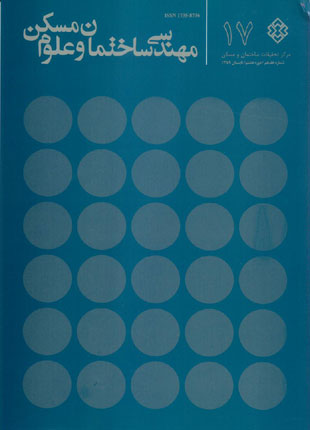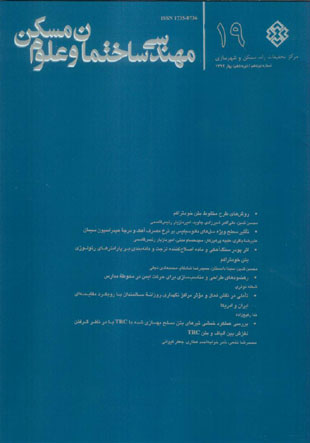فهرست مطالب

فصلنامه مهندسی ساختمان و علوم مسکن
پیاپی 17 (تابستان 1389)
- تاریخ انتشار: 1389/04/04
- تعداد عناوین: 6
-
Page 1Non-uniform settlements are very important in big structures like cooling towers. Because of long diameter, whenever the soil conditions around the ring foundation are not uniform and because of unequal loads induced by wind in columns, non-uniform settlement is expected. In this research, SHAZAND cooling tower has been modeled by ABAQUS software package. In the modeling of foundation and shell, the concrete damaged plasticity model is used, but columns are modeled using the smeared crack one. Non-uniform settlements have applied to foundation in the form of cosine functions with different frequencies. The amplitude of these functions is considered equal to the half of the uniform settlement under gravity load. In the analyses, both of material and geometrical nonlinearities are considered. Results show that foundation displaced horizontally and influenced by severe tension damage. Lateral displacements create significantly in columns and shell in comparison with gravity state so that maximum relative displacement in columns is 0.13 % and maximum relative displacement in shell is 0.062 % that happens at 0.44 of its height.Keywords: R.C. Cooling Towers, Non, uniform Settlement, concrete damaged plasticity model
-
Page 13Different models were proposed by researchers to obtain ideal grading of aggregates for minimum porosity and consequences of that minimum paste. This paper compares different models which are presented by researchers and grading curves recommended by national mix design guideline of Iran for ordinary concrete. This paper also presents the fresh properties of self-consolidating concrete (SCC) mixes contain aggregates with different grading. All the mixes contain limestone powder to maintain viscosity.
-
Page 23Tuned liquid column damper (TLCD) is one of the effective control systems. This damper includes a U shape tube which filled with liquid and has an orifice in horizontal part of it. When the structure is excited by wind or seismic force, the movement of liquid through the tube causes an inertial force in opposite direction of external force that reduces the structural responses such as acceleration and displacement. Also an orifice in horizontal part of the tube limits the movement of liquid through the tube and it changes the damping of system. In this paper various types of control systems and the traits of Semi-Active systems are studied, the TLCD and its governing equations are studied. the performance of TLCD on three types of structures with different heights of 5, 10 and 20 story (respectively 15, 30 and 60 meter) is investigated and in each case the structural responses such as displacement and acceleration for structure without TLCD and for structure with TLCD is obtained, the charts related to the responses is drawn and the performance of the system for different fluid mass ratios is investigated. Given results show that the TLCD can reduce structural responses as desired. Displacement and acceleration can be half of the primary structural responses by using this system.Keywords: Structural control systems, Semi, active control system, Tuned liquid damper (TLD) Tuned liquid column damper (TLCD)
-
Page 47Creating healthy and comfortable spaces is one of the main objects in Sustainable Design. In present paper, the climatic data of meteorological stations of Hormozgan Province and its adjacent provinces have been used to study the effects of climatic condition of main populated points of this province on architectural design of residential buildings. Based on the results of this study, guidelines for architectural design of residential buildings and built environments in the populated cities of Hormozgan province including site selection, building orientation, building materials, size of windows and shading devices, have been offered. These guidelines can be used in all hot and humid climates of Iran.Keywords: Climatic design, Hot, humid climate, Extreme climatic conditions, Design guidelines
-
Page 67In recent years a number of concrete structures in different regions of the various factors that have suffered damage. Rebar corrosion in concrete, including the most common damages in reinforced concrete structures and is one of the major problems that civil engineers are faced in the maintenance of reinforced concrete structures. Concrete structures that they passed several years in the construction determination of corrosion rate of reinforcement are of the effective parameters in retrofitting of structures. In this study to investigate the corrosion of reinforcement in the railway bridge in desert areas, determination of compressive strength, carbonation depth, chloride profiles, reinforcement corrosion potential and corrosion rate of reinforcement on the bridge deck was performed. Finally, compare results and evaluate the appearance, the main reason of reinforcement corrosion was determined. According to results, it seems that rebar corrosion caused by Chloride penetration in desert areas of Iran are Similar to the Persian Gulf shores. Low-quality concrete increases Carbonation depth and facilitates the damages.Keywords: Rebar corrosion, Half Cell, Corrosion rate, Carbonation depth, Chloride profile
-
Page 73Water-soluble chloride, when present in a cement system such as mortar or concrete, can cause metals as steel to corrode. Chloroaluminate produced following the combination of Chloride ions and C3A Phase. Thus, cements of higher C3A amounts are able to bind some chloride. Having bonded with C3A Chloride ions change into insoluble state and become inactive accordingly, that is, bonded and insoluble chlorides have nothing to do with corrosion process. Meanwhile, type of chloride cations plays role in reinforcement corrosion, and corrosion intensity is considerably subject to type of cations. Some aggregates contain remarkable amount of chloride confined therein. Such chloride does not play role in corrosion reaction. According to the test method of ISIRI-8947, part of chloride existing in these aggregates and not contributing to corrosion reaction measured as well. Given that the amount of chloride measured stringently depends on aggregates’ softening point at the time of test preparation, such measured chloride not generally contributing to corrosion reaction therefore measured in this method.The study deals with the results obtained from performance of a research project on “An Investigation on the effect of C3A content of portland cement on formation of chloride chemical bond”, “An Investigation on the effect of different chloride cations on formation of chemical bond” and “An Investigation on test method of water-extractable chloride in cement systems”.Keywords: C3A content, free chlorides, different cations, chemical bond, water, extractable chloride, cement systems


